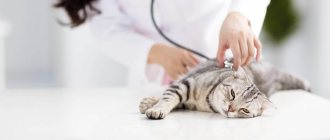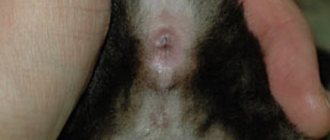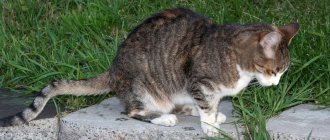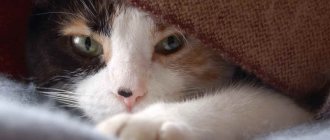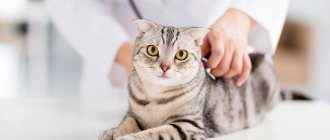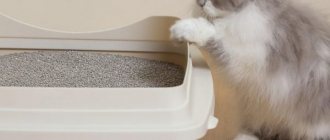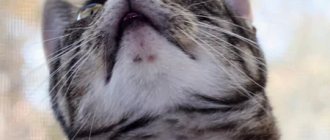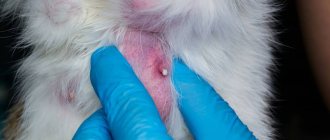Sneezing is a specific protective reaction that is necessary for the body to remove particles from the upper part of the respiratory tract that provoke irritation of the mucous membrane. When a cat sneezes, the cause can be either a physiological or pathological factor.
Physiological sneezing is triggered by the presence of particles in the nasal cavity (dust, fur, plant seeds, pollen). Pathological sneezing in an animal occurs against the background of serious pathological changes in the body, provoked by viruses, bacteria or oncology.
Sneezing itself is a reflex that develops as a result of the influence of the underlying cause on the mechanical and chemoreceptors located in the area of the mucous membrane of the respiratory passages. Irregular attacks of sneezing in a domestic cat can be provoked by external influences, and in this case the owner will be able to help the animal on his own.
If, in addition to sneezing attacks, other signs of your pet’s health are observed, you should immediately contact a veterinary clinic for advice. This is due to the fact that sneezing can indicate serious pathologies in the body.
Causes of colds in cats
Cat colds are a series of infectious diseases of the upper respiratory tract. It responds well to treatment, but lack of timely treatment can lead to serious complications. The immune system of cats is quite well developed and often copes with viruses on its own, so colds in cats are not so common. Among the main causes of infection is decreased immunity and contact with virus carriers.
An unbalanced diet, poor maintenance, low ambient temperature, drafts and stress can trigger the development of a cold in a cat.
Doctor MOM® for the treatment of cough and sore throat
In the complex treatment of cough and sore throat, the use of herbal medicines from the Doctor MOM® line - syrup and herbal cough lozenges - is indicated. Thanks to the unique1 “FITO BRONHO formula”2 based on medicinal plant extracts, the products in the Doctor MOM® line have a complex effect, helping to both relieve unpleasant symptoms and eliminate their cause - inflammation.
The main actions of Doctor MOM® syrup and herbal cough lozenges are:
- Eliminating the cause of cough – inflammation;
- Removing infection from the body3;
- Combating unproductive and unproductive cough.
How does a cold manifest in cats?
Colds in cats. The symptoms of viral diseases in cats are similar, however, successful treatment is only possible with the correct diagnosis. Therefore, when your pet shows signs of a cold, you should urgently consult a specialist. Tests may be needed to determine the virus that causes the illness. Colds are more common in kittens due to their rather weak immunity. The main symptoms include:
- increased body temperature (nose becomes dry and hot)
- lack of appetite
- runny nose and sneezing
- heavy breathing, cough
- tearfulness
- apathy, etc.
Treatment options
To effectively treat dryness, sore throat and cough, it is necessary first of all to act on the cause of their occurrence - inflammation. To make an accurate diagnosis, you should consult a doctor who, depending on the anamnesis (history of the development of the disease), complaints and examination, will immediately suggest a particular disease or prescribe additional examinations and consultations. Since dryness, tickling and cough are not a diagnosis, but only one of the symptoms of the disease, it is necessary to carry out comprehensive treatment, and not limit ourselves to just eliminating unpleasant symptoms. Elimination of pathogens.
In case of infectious origin of tickling and cough, therapy is prescribed that acts on the pathogen - antiviral, antibacterial or antifungal drugs for systemic use (orally or by injection, in the form of rectal suppositories). The selection of an antibiotic or antiviral agent is carried out by a doctor. Under no circumstances should you independently cancel and replace one drug with another or stop taking it earlier - this can lead to the progression of the process or its transition to a chronic stage.
Pain relief
. However, cough and severe sore throat, as a rule, are subjectively difficult for patients to tolerate, causing severe discomfort and disrupting their usual way of life. Therefore, it is difficult to do without the use of symptomatic medications to reduce the severity of complaints. For this purpose, a variety of local remedies are used: tablets and lozenges, sprays, rinsing solutions. If your throat is very sore, frequent warm drinks, warming and distracting procedures can help soothe the irritation of the mucous membranes. If you have a painful, obsessive, prolonged non-productive cough, you may need to prescribe antitussive drugs.
Types of colds
Most often, the causes of colds in cats are acute viral and bacterial infections such as herpes virus, calicivirus, bordetellosis, chlamydia, mycoplasmosis.
Herpes. Viral infection of cats.
The virus is practically unstable and persists for no more than 18 hours in the external environment. Transmission of the virus through contact and household contact. Animals become infected through close contact with each other through household objects, carriers, and cages. After infection, an acute period develops within 2-6 days. Symptoms appear: sneezing, copious mucopurulent discharge from the nose and eyes, breathing through the mouth, depression, fever, redness of the conjunctiva, dermatitis in the nose and eyes, ulcers in the mouth. As a complication, young and weakened cats may develop pneumonia.
On the 20th day, the symptoms subside and a latent period begins, when the cat is clinically healthy, does not release the virus into the external environment, but becomes a lifelong virus carrier. Following immunosuppressive medications, steroid therapy, or stress, the virus may reactivate and the cat may begin to exhibit mild clinical symptoms. Episodes of viral shedding occur in 50% of cats during relapse of the disease.
Feline calicivirus
Stable in the external environment for up to 10 days. Transmission of infection through contact and household contact. The acute period lasts 2-14 days, during which there is damage to the oral mucosa (ulcers and erosions), refusal to feed, and active salivation.
After 20 days, the cat becomes a chronic virus carrier; it will be clinically healthy, but will constantly shed the virus for several years. Since calicivirus has many strains of the virus, a cat that has had one can become infected and become ill with another type of calicivirus.
Chlamydia in cats
The pathogen is unstable in the environment and is transmitted by contact.
The incubation period is from 3 to 14 days. Clinical symptoms: bilateral conjunctivitis, in the acute form, mucopurulent discharge from the nose, sneezing. Isolation of the pathogen after clinical recovery takes several months.
Kittens aged 2 to 12 months are at risk; in cats over 5 years of age, infection is unlikely.
Bordetellosis
The virus is stable in the external environment for up to 10 days and can reproduce in natural bodies of water. Airborne transmission of infection. Accompanied by mucopurulent nasal discharge, sneezing, conjunctivitis. Complications may develop in the form of pneumonia, fever, shortness of breath, and hyporexia. After recovery, the cat continues to excrete the pathogen for several months.
Young kittens are at risk; they also have a high risk of rapid progression of the disease.
Mycoplasmosis
A secondary pathogen in the development of diseases of the upper respiratory tract, the disease itself cannot cause rhinitis. A lot of bacteria normally live in the nose; they can cause rhinitis, but they cannot be primary. Bacteria develop against the background of mucosal injury for any reason: viral damage, foreign body, tumor growth, etc. When an integral layer of mucous membrane is damaged, bacteria begin to actively multiply and cause purulent inflammation. Such rhinitis is secondary and diagnosis of the root cause is necessary.
How to help your pet and how to treat it
If your cat is coughing and sneezing, this may indicate a common cold, but it may also be a sign of a more serious condition. An attentive cat owner should carefully observe the nature of the exudate coming out of the nasal passages when sneezing, as well as monitor the general health of the animal.
The best solution is to contact a veterinary clinic. In addition to the fact that your cat is sneezing frequently, you should contact your veterinarian if there are any of the following signs:
- the appearance of bloody discharge from the nasal passages during the act of sneezing;
- copious discharge from the nose of snot mixed with pus;
- breathing problems in the animal (breathing becomes hoarse, and the cat itself tries to inhale more air with its open mouth);
- increased body temperature;
- The cat is sneezing and coughing heavily.
It is not recommended to treat sneezing and coughing in a cat at home, especially if the owner does not know the exact cause of the reflex.
When contacting a veterinary hospital, a specialist will prescribe a series of laboratory and instrumental tests to establish an accurate diagnosis. Based on the data obtained, the specialist will prescribe the most appropriate treatment, taking into account the individual characteristics of the patient’s body.
Antihistamine medications are widely used to diagnose the allergic nature of sneezing. Colds are treated by prescribing physiotherapy, rinsing the nasal passages, immunomodulating drugs, antimicrobial and antiviral drugs.
Diagnosed viral pathologies of the respiratory tract are treated with immunostimulating drugs, antipyretic and anti-inflammatory drugs. Bacterial infections are treated with a course of antibiotics and special probiotics. Foreign bodies that have entered the respiratory tract are removed using an endoscope, and if necessary, anti-inflammatory drugs are administered.
The diagnosis is bronchial asthma, which requires constant treatment using glucocorticosteroids and antibiotics (in case of a bacterial infection).
Timely vaccinations will help keep your pet healthy and protect it from developing dangerous diseases. Important vaccines are against influenza, panleukopenia, feline leukemia and rabies. Most often, the above diseases pose a danger to small kittens and cats during pregnancy and lactation. Weakened, unvaccinated animals are also at risk.
Pain in the lower abdomen in men
The causes of pain in the lower abdomen in the male population may be associated with pathological conditions of the reproductive and urinary systems. You can see them in the table below:
| Etiology | Character, what is accompanied by |
| Orchitis and epididymitis | Severe pain in the lower abdomen that extends to the groin and even the lower back. |
| Prostatitis | Vivid pain not only in the lower abdomen, but also in the lower back, scrotum, and lower back. |
| Neoplasms of the genitourinary system | Aching pain in the lower abdomen, which becomes more pronounced during sexual intercourse or with prolonged abstinence. |
| Stones in the ureter and lower third of the ureter | Painful symptoms of a spasmodic, girdling nature against the background of elevated body temperature. |
Pain in the lower abdomen: diagnosis
Since the reasons that cause pain symptoms in the lower abdomen can be different, if they occur, you need to contact different specialists. This could be a gynecologist, urologist, gastroenterologist, therapist, surgeon, infectious disease specialist, venereologist, nephrologist, who will prescribe appropriate diagnostic tests to identify the exact cause of the disease. Their list depends on the accompanying symptoms and may include the following:
- Urine, blood and stool tests;
- or MRI;
- Ultrasound examination of the abdominal organs;
- Survey radiography of the abdominal organs;
- Cholecystography;
- Scintigraphy;
- Colonoscopy;
- Other.
How to treat at home if your cat is sneezing
You can treat an animal at home if a veterinarian has conducted an examination, ordered the necessary tests and identified the true cause of the cat’s sneezing. Pet owners, when identifying an allergic reaction in their pets, often ask the question: what to do if the cat sneezes due to an allergy? In this case, the cat is prescribed antihistamines to alleviate its condition and eliminate the allergen.
If the cause of sneezing is polyps, then they can only be removed surgically in a veterinary clinic.
During an asthmatic attack, the animal is prescribed vasodilators, antispasmodics, and corticosteroids.
If the cause of sneezing is diseases of the teeth and gums, the animal’s teeth are treated, tartar is removed, inflammation of the gums is relieved, and vitamins are prescribed.
Gingivitis and tartar in cats
A parasitic cause in a cat is treated with special anthelmintic drugs, which will be recommended by a veterinarian. The owner is required to comply with the exact dosage and frequency of administration of the medicine to the animal.
How to treat if a cat is sneezing and has snot? This question is most often asked by owners of animals with a cold. The animal is prescribed anti-inflammatory drugs, nasal drops, and vitamins.
In the case of an infectious disease confirmed by laboratory tests, antibacterial and antiviral drugs, nasal medications, and immunomodulators are prescribed.
The oncological cause of sneezing in cats can only be eliminated by surgical removal of the tumor and chemotherapy.
Preventive measures
In order to prevent harmless sneezing in a cat, the animal should be kept in a clean room and wet cleaning should be carried out regularly. Cleanliness in the house will protect your pet from foreign objects getting into the nasal cavity. In case of allergic sneezing, you should protect your pet from the influence of the allergen. An effective method of preventing infectious causes in cats is to vaccinate animals according to a schedule. It is necessary to monitor the condition of the pet’s mouth and teeth and regularly remove tartar. To prevent parasitic causes, the animal should be regularly subjected to deworming (destruction of worms) with special preparations.
Sneezing in a cat is a normal physiological process that helps keep the nasal cavity clean. The owner should pay attention to such a reaction if it is regular and multiple. The presence of other symptoms requires an immediate visit to a veterinarian.


